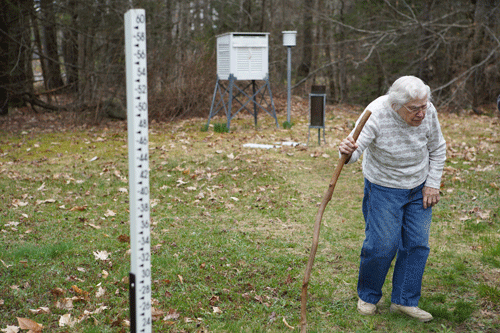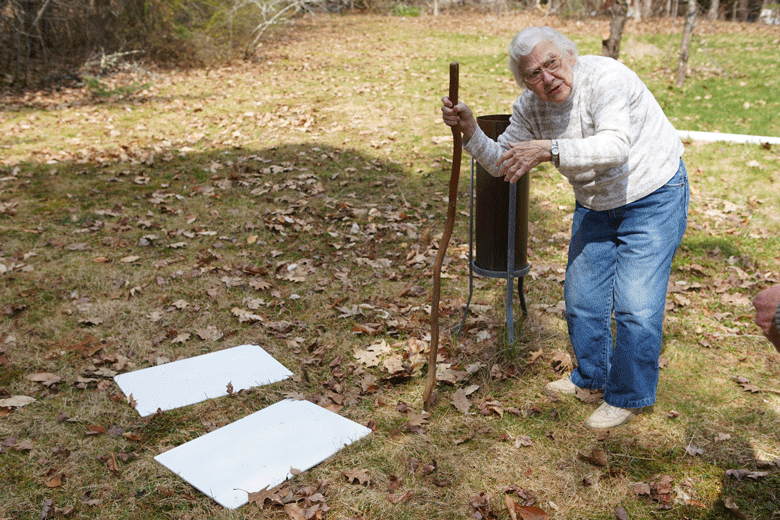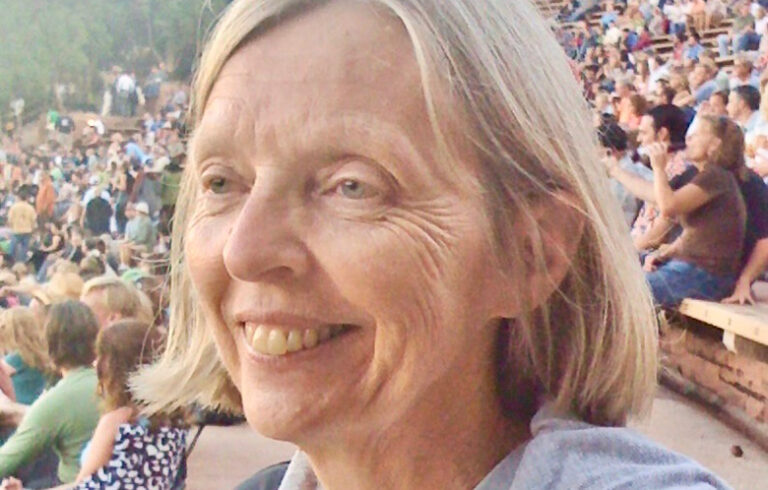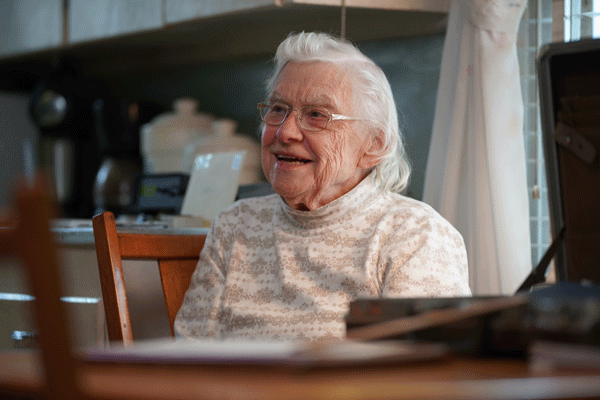
Ask Arlene Cole what the weather was on May 13, 1965, and she’ll tell you the high was 62, the low was 43, and 0.19 inches of intermittent rain fell at her home in Newcastle. In fact, Cole can tell you the weather conditions—the highs and lows, rainfall, snowfall and snow depth in her yard—for each and every day since then.
That date in May more than 58 years ago was the first day that Cole served as an official weather observer for the National Weather Service. She’s been at it every day since and is believed to be the longest-serving and oldest volunteer in the Weather Service’s Cooperative Observer program in Maine.
Like clockwork, Cole takes daily temperature readings from a digital thermometer in her home at 5 p.m. She then trudges outside—at 92, she uses a walking stick and moves a lot slower than she once did—to measure the water or snow in a standard rain gauge, the snow that has fallen since the day before, and the snowpack in her front yard. She mails her information to the weather service each month, while also keeping records of her daily observations in her home.
Cole has also reported her weather observations to the Lincoln County News weekly newspaper for even longer. Her observations have been appearing in the paper every week since 1960.
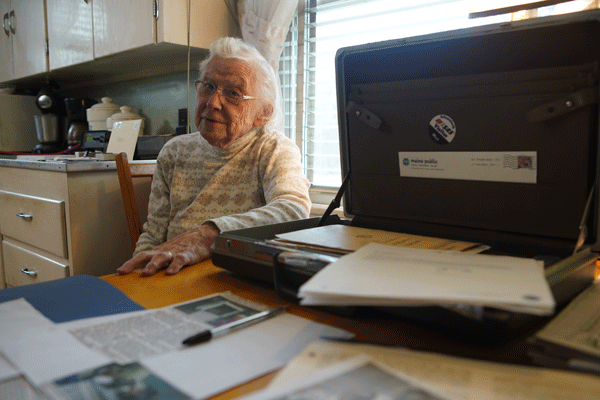
Cole is humble about her work for the weather service and knows the day will come when her duties will come to an end.
“I’m on borrowed time,” she said with a big smile on a recent day at her home. “But I’m enjoying each day.”
Weather has always been an important part of Cole’s life. Growing up on a farm in Jefferson in the 1930s, she recalls her father looking to the east each morning to assess what the day’s weather would bring. Back then, you couldn’t go online or turn on a TV to get the day’s forecast.
After high school, she attended Colby College for three years before marrying her high school sweetheart, George, in 1950. He passed away in 2012.
While raising a family, she began taking weather observations for her own pleasure in 1957 and reporting them to the Lincoln County News beginning in 1960.
She became a National Weather Service observer in 1965, taking over for friend who had passed away. Today, she is one of about 10,000 volunteers nationwide, 63 of them in Maine, in the National Weather Service’s Cooperative Observer Program, which was established in 1890. The observers record temperature and precipitation data in cities and suburbs, at farms, on the seashore, and from mountaintops.
The data are used in real time for the weather service’s forecast models, while also serving as a historical record of the nation’s climate. Nikki Becker, the manager of the observer program for southern Maine and New Hampshire, says observers are “basically the backbone” of the climate network, helping professional meteorologists make their forecasts.
“The cooperative program is really important and what they do matters a lot, not only to our local forecast office but to our whole agency,” she said. “We can’t be everywhere, to collect the weather everywhere. We need help.”
In this high-tech world, Cole uses low-tech equipment to record her observations. The NWS installed a digital thermometer inside her kitchen in 1984 that measures the current and daily high and low temperatures for the day, but there’s still an old white-shuttered wooden shelter in her yard with mercury thermometers that she uses when the power goes out.
For precipitation, she measures the water or snow in an open-mouth can on legs that serves as rain gauge. The snowpack is measured by a 60-inch wooden stake with measurements on the side stuck in the ground. And for the daily snowfall, she has to locate one of two simple 2-by-4-foot boards that lay on the ground and use a rule to measure the snow. Finding the board under all that snow can sometimes be tricky.
When she lumbers outdoors after a snowfall, she wears her late husband’s rubber boats, which are a size or two too big.
“And mittens are very important,” she adds, “because I have to clean off the snow boards.”
Through the decades, Cole’s neighbors and friends have stepped up to take the measurements when she and her family went on vacation. She’s also involved with the Newcastle Historical Society, which she founded in 1998, and wrote a book about the history of the town.
Becker says the weather service is always looking for more volunteers, especially on Maine’s islands.
Cole has been honored with numerous awards for her service and her longevity, many of which are framed and hang on walls in her home. Among them is the program’s highest and most-prestigious honor, the Thomas Jefferson Award, named for the third U.S. president, who kept a nearly unbroken string of weather records from 1776 to 1816.
And while 58 years is a long time to keep weather records, it’s not even close to the record held by Edward Stoll of Nebraska, who served as a weather observer for 76 years, from 1905-1981.
With so much focus on climate change these days, weather data is perhaps more important than ever. But Cole doesn’t inject herself in the climate change debate.
“I keep out of that,” she said. “One of the coldest days I’ve ever recorded was this past winter. Sometimes I think we get less snow, then we get 11 inches and I change my mind. So I don’t get involved in that.”
For more information about the weather observer program, visit: weather.gov/coop/overview.
